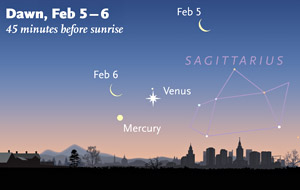This month's astronomy podcast starts before dawn, when you can spot all five bright planets by eye, and moves to the sparkling stars seen on winter evenings.
February is often the coldest month of the year for northerners, but the Sun is telling a different story. The December solstice came and went several weeks ago, and you can already notice that the days are getting longer, with earlier sunrises and later sunsets.

Sky & Telescope diagram
As February opens, be sure to head to head outside at least one day before sunrise. You’ll be rewarded with a showcase of bright stars and — get this — all five of the planets visible to the unaided eye.
In the evening sky, the stars of winter are in control of the nighttime firmament. You'll see the night sky’s most dazzling star is Sirius, down near the southeastern horizon even before twilight completely fades. Sirius serves as the lower anchor for the "Winter Hexagon," a big, wide pattern of bright stars with Orion's red-tinged superstar Betelgeuse at its center.
To get a personally guided tour of these night-sky sights and others overhead during February, download our 7-minute-long astronomy podcast below.
Podcast: Play in new window | Download
Subscribe: Apple Podcasts | Google Podcasts | Spotify | Email | RSS | More
There's no better guide to what's going on in nighttime sky than SkyWatch 2016, a yearlong guide prepared by the editors of Sky & Telescope magazine.
 2
2
Comments
January 30, 2016 at 5:11 pm
Hi! im new to observing and was wondering is it still okay to look at these red giant stars with a telescope? or will I burn my retina 🙂
Thanks in advance
You must be logged in to post a comment.
Antonio Mario
February 9, 2016 at 8:37 am
Hi Kelly,
I guess you mean 'one *hour* before sunrise', right?... 😉
Thanks for the post.
You must be logged in to post a comment.
You must be logged in to post a comment.